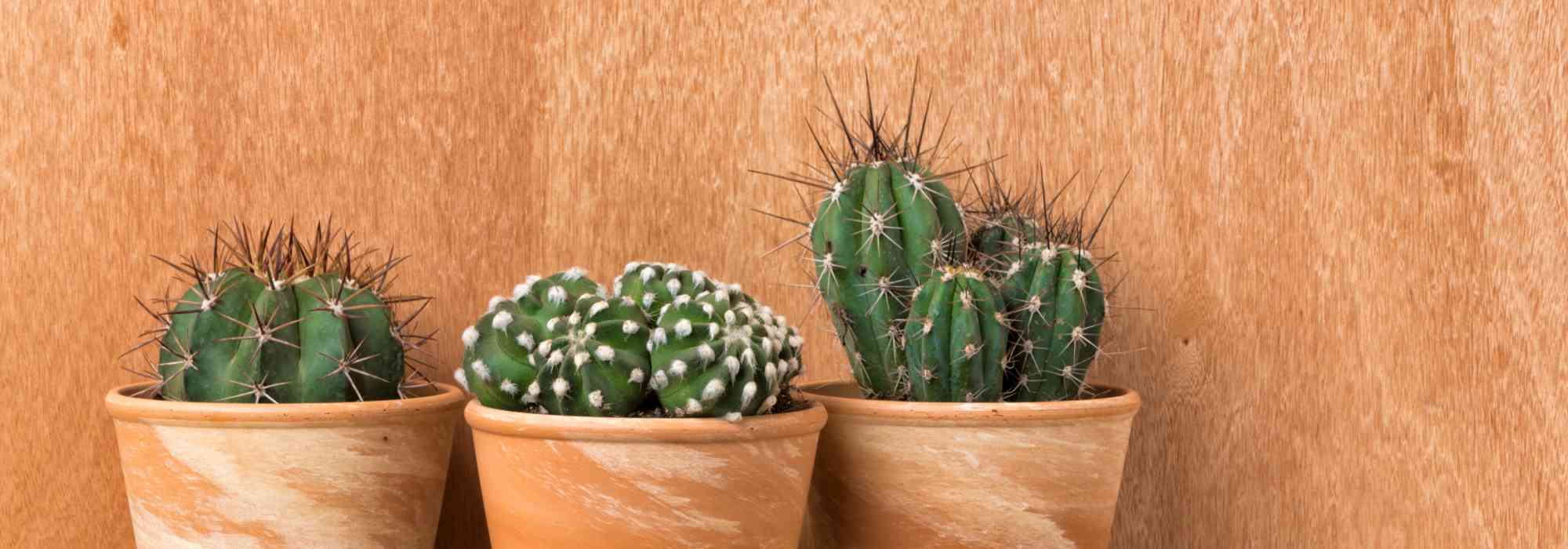
Indoor Cacti: The Easiest Species to Grow
Our Top 10 Easiest Indoor Cacti to Grow... Plus Handy Care Tips!
Contents
Admittedly, we concede, they can be a bit prickly (which is one of their differences from succulents), but cacti hold many advantages for indoor plant enthusiasts who may not necessarily have green fingers. Indeed, cacti combine aesthetics, originality, resilience, and genuine ease of care. These fleshy plants are therefore ideal for those who want a touch of greenery in their home without having to spend hours watering, repotting, pruning, fertilising…
But beware, not all cacti are equal in terms of care. Discover our selection of the ten hardiest cacti that thrive with minimal attention… and plenty of love.
Basic rules for caring for a cactus
Indeed, it’s a fact: cacti are hardy and robust plants that can withstand many cultivation mishaps. However, there’s a big difference between a stunted cactus that merely survives and one that thrives fully, even rewarding you with beautiful flowering. A minimum of care is therefore required to keep your cacti in top condition. But rest assured, it won’t take up hours of your time…
- Light: This is vital for a cactus. That’s why it should be placed near a well-exposed window, such as one facing south or west. A conservatory is also an ideal spot for cacti, as it’s literally bathed in light. These indoor plants can even tolerate direct sunlight, except perhaps in the height of summer. And if you have a garden, balcony, or terrace, they can spend the summer outdoors.
- A light, airy, and perfectly drained substrate: Ideally, provide your cacti with a special cactus compost, or create a mix of 1/3 sand, 1/3 compost, and 1/3 perlite or pumice. Of course, cacti should be planted in pots with drainage holes, preferably plastic rather than terracotta to avoid retaining moisture.
- Moderate watering. Cacti should only be watered when the substrate is dry, roughly from March to October. Then, in winter, watering is practically stopped. Never leave residual water in the saucer or cache-pot.
- A bit of coolness in winter. From October to March, cacti appreciate a rest period in cooler conditions, in a bright room at 5 to 10°C, such as an unheated conservatory. This is the best way to encourage flowering in spring.
- Light fertilisation with a special cactus fertiliser.
The Rebutia, Cacti That flower Easily
Rebutia sp. refers to a species of dwarf globular cacti, native to South America, which benefit from rapid growth. Highly prized for their ease of cultivation, they form small clumps with globular stems, covered in tubercles arranged in spiralled midribs. They are adorned with fine, silky prickles, clustered in tufts. These cacti produce numerous offsets.
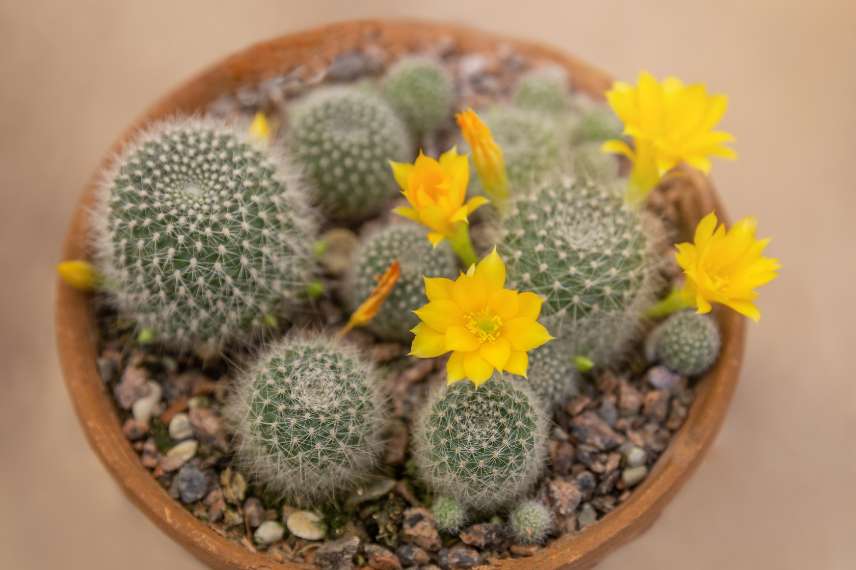
Rebutia senilis
Why we love them? They are drought-resistant but prefer cooler temperatures than other cacti. This is why they thrive outdoors in summer, in a sheltered spot. They flower easily, in red, yellow, or orange.
Our extra tip: This cactus enjoys a moist substrate in summer and occasional water sprays.
The cushion cactus (Mammillaria), with its varied shapes
It is the largest genus in the cactus family, with over 400 species, most of which are native to Central America. The mammillarias (Mammilaria sp.) differ from other cacti in that they lack midribs. Instead, they have swellings or tubercles arranged in spirals, each bearing an areole at its tip with clusters of central and radial prickles. They are often covered in silky white hairs.

Mammilaria cactus
Why we love them: The flowers are arranged in a crown at the top of the stems and are followed by small oblong fruits.
Our best-seller: Mammilaria perbella is very easy to care for, blooms readily in intense red, and requires minimal watering.
Read also
How to water a cactus?The Parodia, with their dense network of thorns
Native to the high regions east of the Andes Mountains, these cacti can be watered more frequently than others. They are spherical or columnar in shape with spiralled midribs and grow in solitary or clustered clumps. The thorns are relatively dense and thin.
Why we love them? The genus Parodia (formerly Notocactus) offers vibrant-coloured flowers, clustered at the top of the stems and of impressive size.
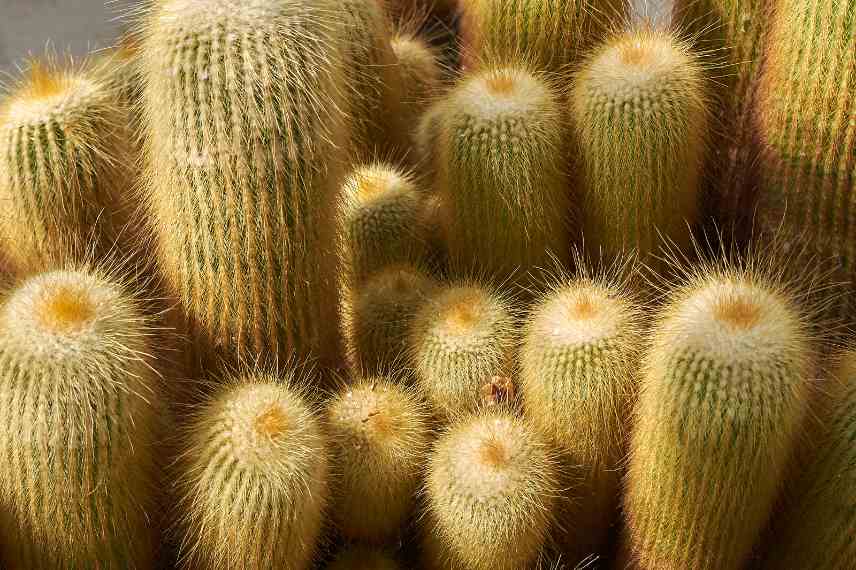
Parodia leninghaussi
Our best-seller: Parodia leninghausii stands out with its yellow prickles that form a golden halo and its lemon-yellow flowering (on mature specimens). It can reach up to 80 cm in height.
The prickly pear (Opuntia microdasys), also known as Mickey Mouse ears
The prickly pear forms dense bushes of 40 to 60 cm in height in its natural habitat in Mexico. In pots, its habit is more compact. This is a cactus without midribs, but it develops velvety stem segments, ovate and flattened in shape, covered with areoles bearing tiny bristles with curved and sharp tips.
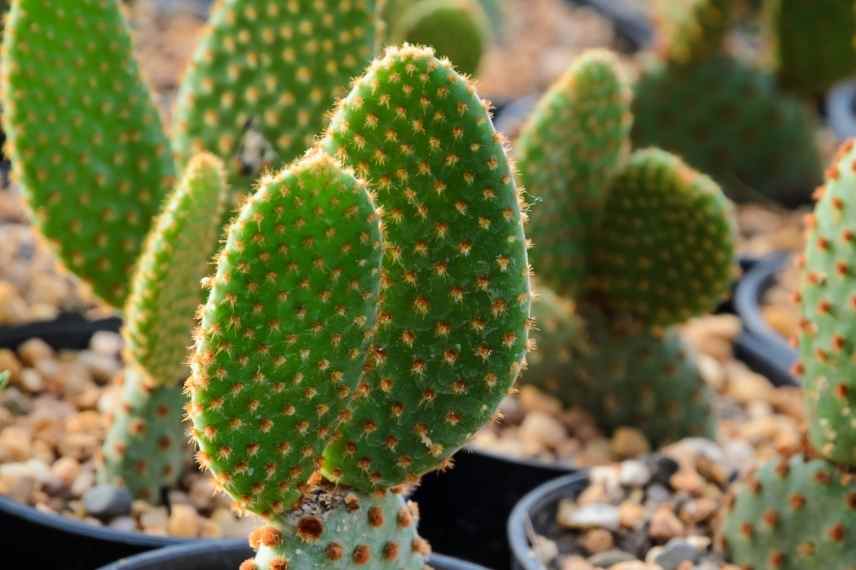
Opuntia microdasys
Why we love it? It’s a fast-growing cactus that can produce one to two prickly pears per year. However, as its irritating bristles easily embed in the skin, it should be placed away from any foot traffic.
Our best-seller: Opuntia microdasys ‘Undulata’ is a remarkable variety with undulate prickly pears that resemble a coral reef, in yellowish-green colour and covered with yellow to tawny glochidia (bristles).
The bishop's cap cactus (Astrophytum myriostigma), a thornless variety
This cactus, shaped like a bishop’s mitre, is an inermous species (without prickles), dotted with small fluffy areoles that protect it from the scorching Mexican sun. Yellow flowers bloom successively at the top of the plant in summer. Initially globular, the bishop’s cap cactus (Astrophytum myriostigma) can develop into a column over time.
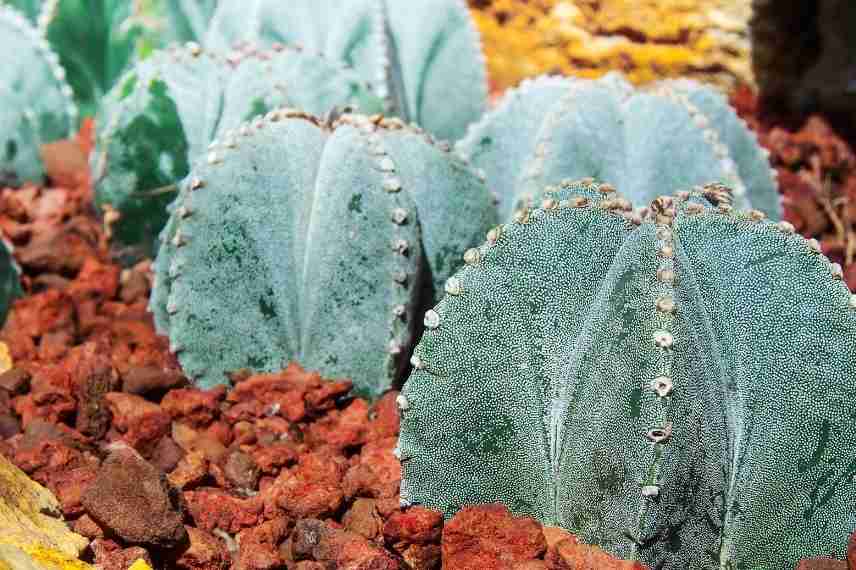
Astrophytum myriostigma
Why we love it? Since the roots are prone to rot, it only requires sparing watering. It thrives in direct sunlight. In other words, it’s very accommodating!
The extra little tip: We also adore its cousin, Astrophytum ornatum, with its woolly areoles—fewer in number but larger—and its long, slender, often golden-yellow prickles.
The Mother-in-law's Cushion Cactus (Echinocactus grusonii), still popular
Echinocactus grusonii is a cactus native to Mexico, now widely cultivated. When young, this globular plant features small projections from which prickles emerge. Later, the prickles merge into midribs bristling with long golden-yellow prickles.
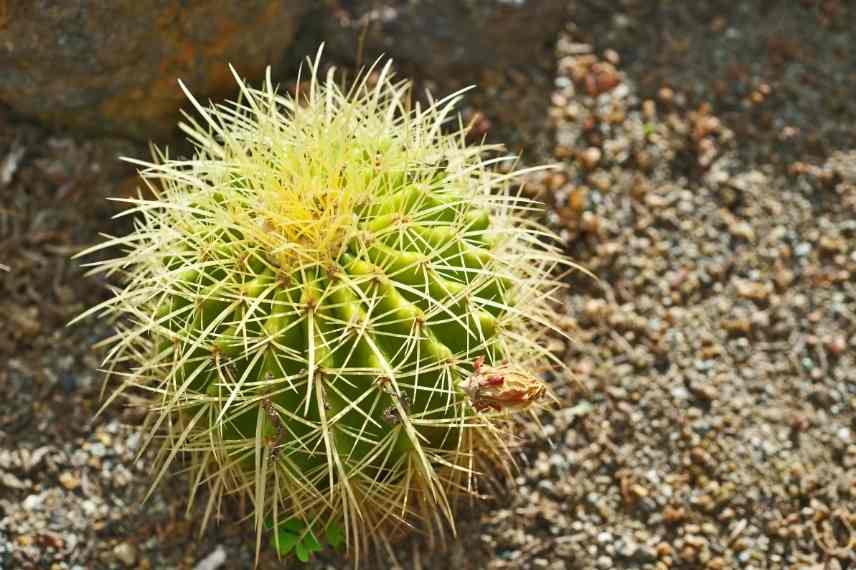
Echinocactus grusonii
Why we love it? It tolerates drought very well and thrives in full sun. After 20 years, it can reach 60 cm in height and 90 cm in diameter.
Our best-seller: Echinocactus grusonii var. brevispinus is a variety of mother-in-law’s cushion with shorter and finer thorns, sometimes almost non-existent.
The Peruvian Apple Cactus (Cereus peruvianus), with its rapid growth
The Peruvian Apple Cactus (Cereus peruvianus) is a columnar cactus with a dark green colour, producing several stems marked by 5 to 9 thick, rounded midribs, bearing brown areoles. From each areole emerge 8 to 9 yellow or reddish-brown prickles. This cactus benefits from relatively rapid growth.

Cereus peruvianus
Why we love it? In very good growing conditions, this cactus flowers in summer. The funnel-shaped, spreading flowers are white and fragrant, blooming at night. The outer petals are sometimes tinged with greenish-brown or red at their tips.
The little extra: It can reach 1 m in height after several years. It loves basking in full sun outdoors during the height of summer.
The woolly torch cactus (Espostoa lanata), with its lovely white fleece
Espostoa lanata is a columnar cactus with a woolly appearance thanks to its long white hairs. This white fleece makes it particularly decorative. In a pot, it can reach up to 2 metres in height. It may flower, but the flowers remain practically invisible among the hairs. However, flowering is very rare indoors.
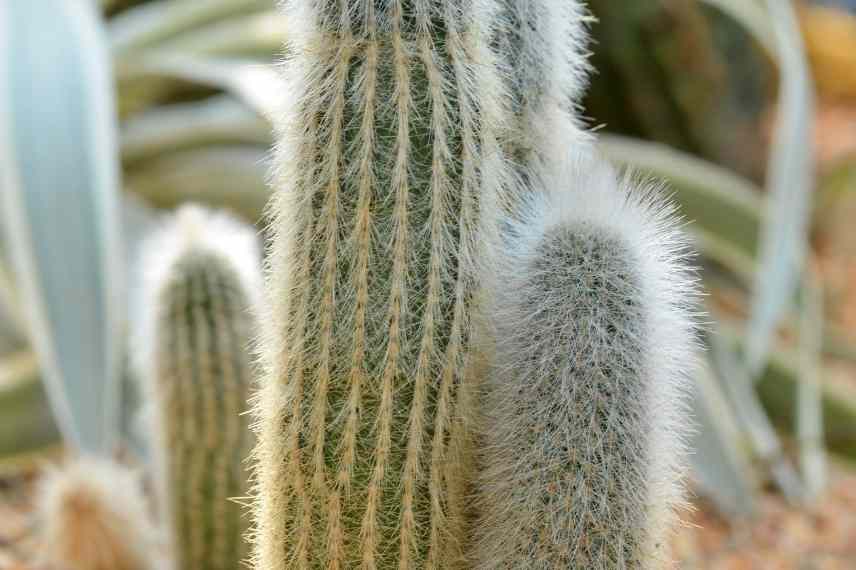
Espostoa lanata
Why we love it: This cactus has rapid growth. It will enjoy spending the summer outdoors in the sun. It can remain outside down to -12°C if well sheltered from the elements.
The extra little tip: We also love its cousin Espostoa churinensis, which stands out with its even more pilous, ramified branches from the base.
The barrel cactus (Ferocactus), with its rounded shape
Native to the southwestern United States and northeastern Mexico, the genus Ferocactus takes the form of a barrel over 1 m tall in its natural habitat. In our homes, its dimensions remain much more modest. It is a globular cactus, almost spherical at ripeness, with increasingly pronounced midribs as it ages. Its prickles are very acute and vary in shape or pattern depending on the species and variety.
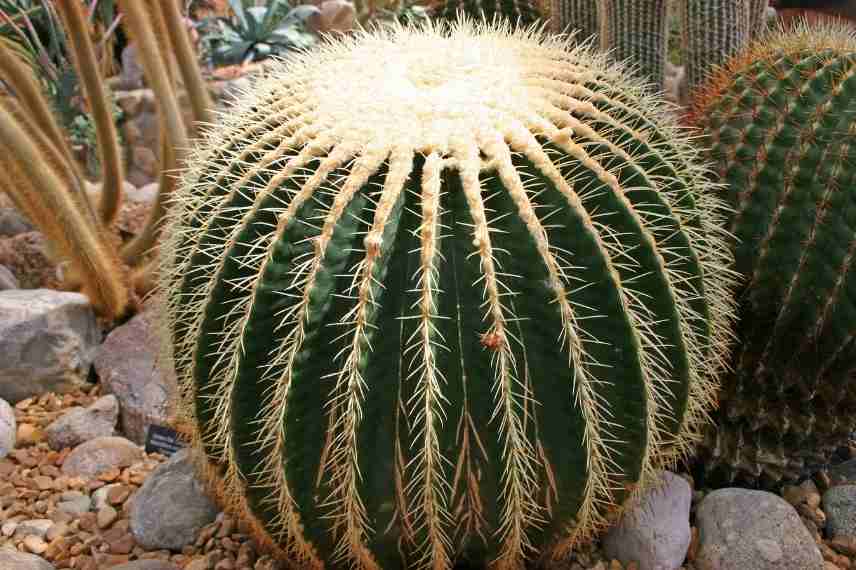
Ferocactus
Why we love it? It is a very easy-to-grow cactus that thrives in full heat. It flowers quite well if placed in a conservatory, warm during the day and cool at night.
Our best-seller: Ferocactus glaucescens ‘Inermis’ maintains its globular shape well and is thorn-free.
The melon cactus (Melocactus bahiensis) and its pink cap
Melocactus bahiensis is a globular cactus with bristly midribs covered in prickles, which develops a “cap”, in the form of a tuft of hard bristles and reddish hairs from which pink flowers emerge, followed by red fruits. This cephalium eventually transforms into a column. But it will take a few years…
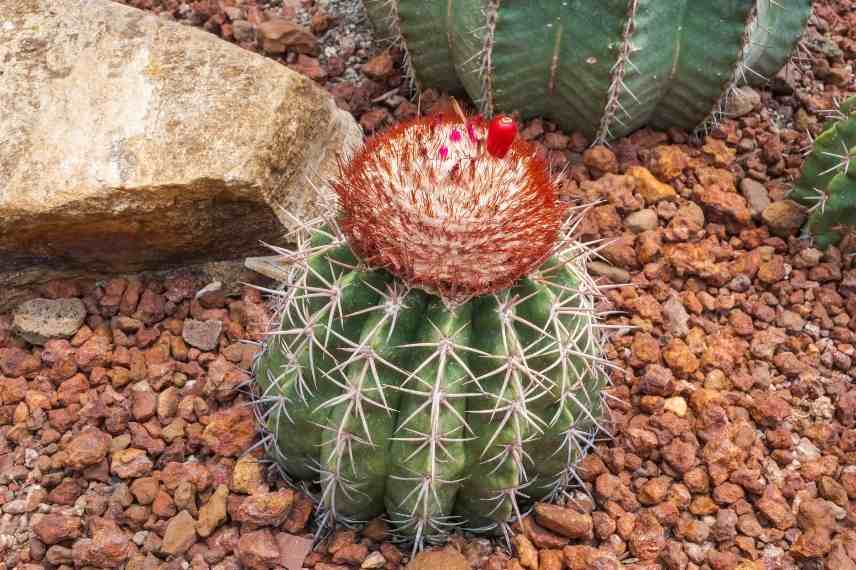
Melocactus bahiensis
Why we love it? We love it especially for its originality, as it seems to be wearing a cosy winter hat.
The little extra: This cactus thrives in sunlight and warmth. And, in winter, it should be placed in a bright room with a temperature of at least 10°C.
- Subscribe!
- Contents
































Comments